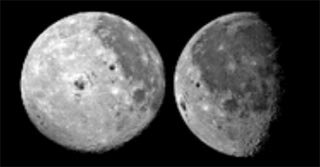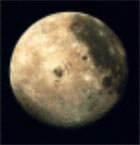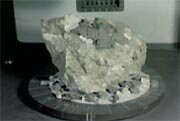

Оглавление РефератыThe MoonII. The Moon: General Information2) Atmosphere and terrain The Moon has no atmosphere. But evidence from Clementine suggested that there may be water ice in some deep craters near the Moon's south pole which are permanently shaded. This has now been confirmed by Lunar Prospector. There is apparently ice at the north pole as well. The cost of future lunar exploration just got a lot cheaper! The Moon's crust averages 68 km thick and varies from essentially 0 under Mare Crisium to 107 km north of the crater Korolev on the lunar far side. Below the crust is a mantle and probably a small core (roughly 340 km radius and 2% of the Moon's mass). Unlike the Earth, however, the Moon's interior is no longer active. Curiously, the Moon's center of mass is offset from its geometric center by about 2 km in the direction toward the Earth. Also, the crust is thinner on the near side. There are two primary types of terrain on the Moon: the heavily cratered and very old highlands and the relatively smooth and younger maria. The maria (which comprise about 16% of the Moon's surface) are huge impact craters that were later flooded by molten lava. Most of the surface is covered with regolith, a mixture of fine dust and rocky debris produced by meteor impacts. For some unknown reason, the maria are concentrated on the near side.  Figure 4
Most of the craters on the near side are named for famous figures in the history of science such as Tycho, Copernicus, and Ptolemaeus. Features on the far side have more modern references such as Apollo, Gagarin and Korolev (with a distinctly Russian bias since the first images were obtained by Luna 3). In addition to the familiar features on the near side, the Moon also has the huge craters South Pole-Aitken on the far side which is 2250 km in diameter and 12 km deep making it the the largest impact basin in the solar system and Orientale on the western limb (as seen from Earth; in the center of the image at left) which is a splendid example of a multi-ring crater. The Moon is also the only body from which samples have been returned to Earth. In the summer of 1994, the Moon was very extensively mapped by the little spacecraft Clementine and again in 1999 by Lunar Prospector.
A total of 382 kg of rock samples were returned to the Earth by the Apollo and Luna programs. These provide most of our detailed knowledge of the Moon. They are particularly valuable in that they can be dated. Even today, more than 30 years after the last Moon landing, scientists still study these precious samples. Most rocks on the surface of the Moon seem to be between 4.6 and 3 billion years old. This is a fortuitous match with the oldest terrestrial rocks which are rarely more than 3 billion years old. Thus the Moon provides evidence about the early history of the Solar System not available on the Earth.
|
|
Конкурс рефератов: Тема: The Moon Автор : БАННЕРЫ: |


